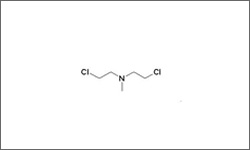Mechlorethamine

Mechlorethamine (Mustargen®, Chlormethine, Nitrogen mustard) is an alkylating agent used primarily in the treatment if Hodgkin's disease as part of the MOPP regimen (Mechlorethamine, Oncovin®, Prednisone, Procarbazine). Other malignancies for which mechlorethamine is used include chronic lymphocytic leukemia, chronic myelogenous leukemia, small cell lung cancer, medulloblastoma non-Hodgkin's lymphoma. Mechlorethamine is commonly administered via injection.1
- 1Chu, E., & DeVita, V. T. (2015). Physicians' cancer chemotherapy drug manual 2015. Burlington, MA: Jones & Bartlett Learning.
Mechlorethamine, which is an analog of mustard gas, is an alkylating agent that prevents DNA synthesis and RNA transcription by attaching alkyl groups to DNA bases, forms cross-links on DNA, and mispairs nucleotides which causes mutations.1
The structure above shows the 3D diagram of Mechlorethamine.
- 1Chu, E., & DeVita, V. T. (2015). Physicians' cancer chemotherapy drug manual 2015. Burlington, MA: Jones & Bartlett Learning.
Common side effects include myelosuppression, nausea, vomiting, pain at site of injection, and alopecia. These effects can be diminished by pre-treatment with cannabinoids or phenothizine, severe bone marrow depression limits extensive use and latent viral infections may appear because of the immunosuppressive effects of the drug.1
- 1Chu, E., & DeVita, V. T. (2015). Physicians' cancer chemotherapy drug manual 2015. Burlington, MA: Jones & Bartlett Learning.
